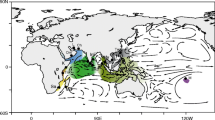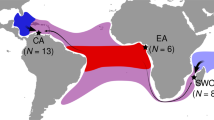Abstract
Blue mussels in the genus Mytilus first arrived in the Atlantic Ocean from the Pacific during the Pliocene, following the opening of the Bering Strait. Repeated periods of glaciation throughout the Pleistocene led to re-isolation of the two ocean basins and the allopatric divergence of Mytilus edulis in the Atlantic and M. trossulus in the Pacific. Mytilus trossulus has subsequently colonized the northwest Atlantic (NW Atlantic) so that the two species are presently sympatric and hybridize throughout much of the Canadian Maritimes and the Gulf of Maine. To estimate when M. trossulus arrived in the NW Atlantic, we have examined sequence variation within a portion of the female mtDNA lineage large untranslated region (F-LUR) for 156 mussels sampled from three Pacific and eleven Atlantic populations of M. trossulus. Although we found no evidence of reciprocal monophyly for Pacific and NW Atlantic M. trossulus, limited gene flow between ocean basins has led to the divergence of unique sequence clades within each ocean basin. In contrast, relative genetic homogeneity indicates high levels of gene flow within each basin. Coalescence-based analysis of the F-LUR sequences suggests that M. trossulus recolonized the NW Atlantic from the northeast Pacific subsequent to a demographic expansion in the Pacific that occurred ~96,000 years before present (ybp). Estimates of timing of divergence for Pacific and NW Atlantic populations and the time since expansion among NW Atlantic sequence clades indicate that M. trossulus arrived in the NW Atlantic more recently, between 20,000 and 46,000 ybp. Given that these estimates overlap with the dates of peak ice in the NW Atlantic during the last glacial maximum (LGM, ~18,000–21,000 ybp), we suggest that colonization of the NW Atlantic by M. trossulus occurred during, but more likely just subsequent to, the LGM and was followed by rapid temporal and spatial expansion in the region.





Similar content being viewed by others
References
Addison JA, Hart MW (2005) Colonization, dispersal, and hybridization influence phylogeography of north Atlantic sea urchins (Strongylocentrotus droebachiensis). Evol Int J Org Evol 59:532–543
Ayala F (1997) Vagaries of the molecular clock. Proc Natl Acad Sci USA 94:7776–7783. doi:https://doi.org/10.1073/pnas.94.15.7776
Bandelt H-J, Forster P, Röhl A (1999) Median-joining networks for inferring intraspecific phylogenies. Mol Biol Evol 16:37–48
Bates JA, Innes DJ (1995) Genetic variation among populations of Mytilus spp. in eastern Newfoundland. Mar Biol (Berl) 124:417–424. doi:https://doi.org/10.1007/BF00363915
Beaumont AR, Hawkins MP, Doig FL, Davies IM, Snow M (2008) Three species of Mytilus and their hybrids identified in a Scottish Loch: natives, relicts and invaders? J Exp Mar Biol Ecol 367:100–110. doi:https://doi.org/10.1016/j.jembe.2008.08.021
Bigg GR, Cunningham CW, Ottersen G, Pogson GH, Wadley MR, Williamson P (2008) Ice-age survival of Atlantic cod: agreement between palaeoecology models and genetics. Proc R Soc Lond B Biol Sci 275:163–172. doi:https://doi.org/10.1098/rspb.2007.1153
Burzyński A, Zbawicka M, Skibinski DOF, Wenne R (2003) Evidence for recombination of mtDNA in the marine mussel Mytilus trossulus from the Baltic. Mol Biol Evol 20:388–392. doi:https://doi.org/10.1093/molbev/msg058
Cao L, Kenchington E, Zouros E, Rodakis GC (2004) Evidence tha the large noncoding sequence is the main control region of maternally and paternally transmitted mitochondrial genomes of the marine mussel (Mytilus spp.). Genetics 167:835–850. doi:https://doi.org/10.1534/genetics.103.026187
Comesaña AS, Toro JE, Innes DJ, Thompson RJ (1999) A molecular approach to the ecology of a mussel (Mytilus edulis-M. trossulus) hybrid zone on the east coast of Newfoundland, Canada. Mar Biol (Berl) 133:213–221. doi:https://doi.org/10.1007/s002270050460
Cronin TM (1988) Evolution of marine climates of the U.S. Atlantic coast during the past four million years. Philos Trans R Soc Lond Ser B 318:661–678. doi:https://doi.org/10.1098/rstb.1988.0029
Cunningham CW (2007) How to use genetic data to distinguish between natural and human-mediated introduction of Littorina littorea to North America. Biol Inv 10:1–6. doi:https://doi.org/10.1007/s10530-007-9099-8
Darby DA, Polyak L, Bauch HA (2006) Past glacial and interglacial conditions in the Arctic Ocean and marginal seas—a review. Prog Oceanogr 71:129–144. doi:https://doi.org/10.1016/j.pocean.2006.09.009
Dawson AG (1992) Ice age earth: late quaternary geology and climate. Routledge, New York
Dodson JJ, Tremblay S, Colombani F, Carscadden JE, Lecomte F (2007) Trans-Arctic dispersals and the evolution of a circumpolar marine fish species complex, the capelin (Mallotus villosus). Mol Ecol 16:5030–5043. doi:https://doi.org/10.1111/j.1365-294X.2007.03559.x
Dyke AS, Andrews JT, Clark PU, England JH, Miller GH, Shaw J, Veillette JJ (2002) The Laurentide and Innuitian ice sheets during the last glacial maximum. Quat Sci Rev 21:9–31. doi:https://doi.org/10.1016/S0277-3791(01)00095-6
Excoffier L, Smouse P, Quattro J (1992) Analysis of molecular variance inferred from metric distances among DNA haplotypes: applications to human mitochondrial DNA restriction data. Genetics 131:479–491
Fu Y-X (1997) Statistical tests of neutrality of mutations against population growth, hitchhiking and background selection. Genetics 147:915–925
Geller JB, Carlton JT, Powers DA (1994) PCR-based detection of mtDNA haplotypes of native and invading mussels on the northeastern Pacific coast: latitudinal pattern of invasion. Mar Biol (Berl) 119:243–249. doi:https://doi.org/10.1007/BF00349563
Heath DD, Rawson PD, Hilbish TJ (1995) PCR-based nuclear markers identify alien blue mussel (Mytilus spp.) genotypes on the west coast of Canada. Can J Fish Aquat Sci 52:2621–2627. doi:https://doi.org/10.1139/f95-851
Hewitt GM (1996) Some genetic consequences of ice ages and their role in divergence and speciation. Bot J Linn Soc 58:247–276
Hewitt GM (2000) The genetic legacy of the quaternary ice ages. Nature 405:907–913. doi:https://doi.org/10.1038/35016000
Hey J, Nielsen R (2004) Multilocus methods for estimating population sizes, migration rates and divergence time, with applications to the divergence of Drosophila pseudobscura and D. persimilis. Genetics 167:747–760. doi:https://doi.org/10.1534/genetics.103.024182
Ho SYW, Phillips MJ, Cooper A, Drummond AJ (2005) Time dependency of molecular rate estimates and systematic overestimation of recent divergence times. Mol Biol Evol 22:1561–1568. doi:https://doi.org/10.1093/molbev/msi145
Hoffman RJ, Boore JL, Brown WM (1992) A novel mitochondrial genome organization for the blue mussel, Mytilus edulis. Genetics 131:397–412
Ingolfsson A (1992) The origin of the rocky shore fauna of Iceland and the Canadian Maritimes. J Biogeography 19:705–712. doi:https://doi.org/10.2307/2845711
Kaufman DS, Ager TA, Anderson NJ, Anderson PM, Andrews JT, Bartlein PJ, Brubaker LB, Coats LL, Cwynar LC, Duvall ML, Dyke AS, Edwards ME, Eisner WR, Gajewski K, Geirsdottir A, Hu FS, Jennings AE, Kaplan MR, Kerwin MW, Lozhkin AV, MacDonald GM, Miller GH, Mock CJ, Oswald WW, Otto-Bliesner BL, Porinchu DF, Ruhland K, Smol JP, Steig EJ, Wolfe BB (2004) Holocene thermal maximum in the western Arctic. Quat Sci Rev 23:529–560. doi:https://doi.org/10.1016/j.quascirev.2003.09.007
Luttikhuizen PC, Drent J, Baker AJ (2003) Disjunct distribution of highly diverged mitochondrial lineage clade and population subdivision in a marine bivalve with pelagic larval dispersal. Mol Ecol 12:2215–2229. doi:https://doi.org/10.1046/j.1365-294X.2003.01872.x
Marincovich L, Gladenkov AY (1998) Evidence for an early opening of the Bering Strait. Nature 397:149–151. doi:https://doi.org/10.1038/16446
McDonald JH, Seed R, Koehn RK (1991) Allozymes and morphometric characters of three species of Mytilus in the Northern and Southern Hemispheres. Mar Biol (Berl) 111:323–333. doi:https://doi.org/10.1007/BF01319403
Nikula R, Strelkov P, Väinölä R (2007) Diversity and trans-Arctic invasion history of mitochondrial lineages in the North Atlantic Macoma balthica complex (Bivalvia: Tellinidae). Evol Int J Org Evol 61:928–941. doi:https://doi.org/10.1111/j.1558-5646.2007.00066.x
O’Foighil D, Jozefowicz CJ (1999) Amphi-Atlantic phylogeography of direct developing lineages of Lasaea, a genus of brooding bivalves. Mar Biol (Berl) 135:115–122. doi:https://doi.org/10.1007/s002270050608
Palumbi SR, Kessing BD (1991) Population biology of the trans-Arctic exchange: mtDNA sequence similarity between Pacific and Atlantic sea urchins. Evol Int J Org Evol 45:1790–1805. doi:https://doi.org/10.2307/2409832
Palumbi SR, Wilson AC (1990) Mitochondrial DNA diversity in the sea urchins Strongylocentrotus purpuratus and S. droebachiensis. Evol Int J Org Evol 44:403–415. doi:https://doi.org/10.2307/2409417
Posada D, Crandall KA (1998) Modeltest: testing the model of DNA substitution. Bioinformatics 14:817–818. doi:https://doi.org/10.1093/bioinformatics/14.9.817
Quesada H, Wenne R, Skibinski DOF (1995) Differential introgression of mitochondrial DNA across species boundaries within the marine mussel genus Mytilus. Proc R Soc Lond B Biol Sci 262:51–56. doi:https://doi.org/10.1098/rspb.1995.0175
Ramos-Onsins SE, Rozas J (2002) Statistical properties of new neutrality tests against population growth. Mol Biol Evol 19:2092–2100
Rawson PD (2005) Nonhomologous recombination between the large unassigned region of the male and female mitochondrial genomes in the mussel Mytilus trossulus. J Mol Evol 61:717–732. doi:https://doi.org/10.1007/s00239-004-0035-6
Rawson PD, Hilbish TJ (1998) Asymmetric introgression of mitochondrial DNA among European populations of blue mussels (Mytilus spp.). Evol Int J Org Evol 52:100–108. doi:https://doi.org/10.2307/2410924
Rawson PD, Joyner KL, Meetze K, Hilbish TJ (1996) Evidence for intragenic recombination within a novel genetic marker that distinguishes mussels in the Mytilus edulis species complex. Heredity 77:599–607. doi:https://doi.org/10.1038/hdy.1996.187
Rawson PD, Hayhurst S, VanScoyoc B (2001) Species composition of blue mussel populations in the northeastern Gulf of Maine. J Shellfish Res 20:31–38
Riginos C, Cunningham CW (2005) Local adaptation and species segregation in two mussel (Mytilus edulis × Mytilus trossulus) hybrid zones. Mol Ecol 14:381–400. doi:https://doi.org/10.1111/j.1365-294X.2004.02379.x
Riginos C, Henzler CM (2008) Patterns of mtDNA diversity in North Atlantic populations of the mussel Mytilus edulis. Mar Biol (Berl) 155:399–412. doi:https://doi.org/10.1007/s00227-008-1038-4
Riginos C, Hickerson MJ, Henzler CM, Cunningham CW (2004) Differential patterns of male and female mtDNA exchange across the Atlantic Ocean in the blue mussel, Mytilus edulis. Evol Int J Org Evol 58:2438–2451
Riser JAM (2001) Quaternary geology and the environment. Praxis Publishing, Chichester
Rogers AR, Harpending H (1992) Population growth makes waves in the distribution of pairwise genetic differences. Mol Biol Evol 9:552–569
Schneider S, Roessli D, Excoffier L (2000) Arlequin ver. 2.0. software for population genetic data analysis. Genetics and Biometry Laboratory, University of Geneva, Switzerland
Suchanek TH, Geller JB, Kresier BR, Mitton JB (1997) Zoogeographic distributions of the sibling species Mytilus galloprovincialis and M. trossulus (Bivalvia: Mytilidae) and their hybrids in the North Pacific. Biol Bull 193:187–194. doi:https://doi.org/10.2307/1542764
Swofford DL (2001) PAUP*: Phylogenetic analysis using parsimony (* and Other Methods), Ver. 4. Sinauer Associates. Massachusetts, Sunderland
Tajima F (1989) Statistical method for testing the neutral mutation hypothesis by DNA polymorphism. Genetics 123:585–595
Thompson JD, Gibson TJ, Plewniak F, Jeanmougin F, Higgins DG (1997) The ClustalX-Windows interface: flexible strategies for multiple sequence alignment aided by quality analysis tools. Nucleic Acids Res 25:4876–4882. doi:https://doi.org/10.1093/nar/25.24.4876
Väinölä R (2003) Repeated trans-Arctic invasions in littoral bivalves: molecular zoogeography of the Macoma balthica complex. Mar Biol (Berl) 143:935–946. doi:https://doi.org/10.1007/s00227-003-1137-1
Väinölä R, Varvio SL (1989) Biosystematics of Macoma balthica in northwestern Europe. In: Ryland JS, Tyler PA (eds) Reproduction, genetics and distribution of marine organisms. 23rd Eur Mar Bio Symp Olsen & Olsen. Fredensborg, Denmark, pp 309–316
Vermeij GJ (1991) Anatomy of an invasion: the trans-Arctic interchange. Paleobiology 17:281–307
Vermeij GJ (2005) From Europe to America: pliocene to recent trans-Atlantic expansion of cold-water North Atlantic molluscs. Proc R Soc Lond B Biol Sci 272:2545–2550. doi:https://doi.org/10.1098/rspb.2005.3177
Wares JP, Cunningham CW (2001) Phylogeography and historical ecology of the North Atlantic intertidal. Evol Int J Org Evol 55:2455–2469
Won Y-J, Hey J (2005) Divergence population genetics of chimpanzees. Mol Biol Evol 22:297–307. doi:https://doi.org/10.1093/molbev/msi017
Zbawicka M, Wenne R, Skibinski DOF (2003) Mitochondrial DNA variation in populations of the mussel Mytilus trossulus from the Southern Baltic. Hydrobiologia 499:1–12. doi:https://doi.org/10.1023/A:1026356603105
Acknowledgments
We thank R. Tremblay, B. Konar, D. Heath, A. Mallet, D. Innes, M. Miranda, and C. Langdon for providing samples of blue mussels or blue mussel DNA from populations we could not visit ourselves. A. McGowen provided technical support on this project and C. Riginos provided constructive comments on several earlier drafts. This project was funded by the National Science Foundation (DEB0315891) and the Maine Sea Grant College (R/FMD-279).
Author information
Authors and Affiliations
Corresponding author
Additional information
Communicated by T. Reusch.
Rights and permissions
About this article
Cite this article
Rawson, P.D., Harper, F.M. Colonization of the northwest Atlantic by the blue mussel, Mytilus trossulus postdates the last glacial maximum. Mar Biol 156, 1857–1868 (2009). https://doi.org/10.1007/s00227-009-1218-x
Received:
Accepted:
Published:
Issue Date:
DOI: https://doi.org/10.1007/s00227-009-1218-x




